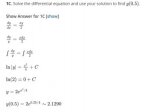koreamaniac101
New member
- Joined
- Dec 20, 2016
- Messages
- 7
For this following equation:
. . . . .\(\displaystyle \dfrac{dy}{dx}\, =\, \dfrac{xy}{2};\, y(0)\, =\, 2\)
I was instructed to use Euler's Method to solve it. However, after doing two iterations of Euler's Method, I was asked to definitively solve the equation for x=0.5. This is the solution they gave:
. . . . .\(\displaystyle \dfrac{dy}{dx}\, =\, \dfrac{xy}{2};\, y(0)\, =\, 2\)
. . . . .\(\displaystyle \dfrac{dy}{y}\, =\, \dfrac{x\, dx}{2}\)
. . . . .\(\displaystyle \displaystyle \int\, \dfrac{dy}{y}\, =\, \int\, \dfrac{x\, dx}{2}\)
. . . . .\(\displaystyle \ln|y|\, =\, \dfrac{x^2}{4}\, +\, C\)
. . . . .\(\displaystyle \ln(2)\, =\, 0\, +\, C\)
. . . . .\(\displaystyle y\, =\, 2\, e^{x^2 / 4}\)
. . . . .\(\displaystyle y(0.5)\, =\, 2\, e^{0.25 / 4}\, \approx\, 2.1290\)
My question is: when they plugged in the (0,2) initial coordinate into the equation, didn't they solve for C. If so, why isnt C part of the exponent for the e on the right side? When they solved for the natural log of y, shouldn't the e on the other side include the c value?
. . . . .\(\displaystyle \dfrac{dy}{dx}\, =\, \dfrac{xy}{2};\, y(0)\, =\, 2\)
I was instructed to use Euler's Method to solve it. However, after doing two iterations of Euler's Method, I was asked to definitively solve the equation for x=0.5. This is the solution they gave:
. . . . .\(\displaystyle \dfrac{dy}{dx}\, =\, \dfrac{xy}{2};\, y(0)\, =\, 2\)
. . . . .\(\displaystyle \dfrac{dy}{y}\, =\, \dfrac{x\, dx}{2}\)
. . . . .\(\displaystyle \displaystyle \int\, \dfrac{dy}{y}\, =\, \int\, \dfrac{x\, dx}{2}\)
. . . . .\(\displaystyle \ln|y|\, =\, \dfrac{x^2}{4}\, +\, C\)
. . . . .\(\displaystyle \ln(2)\, =\, 0\, +\, C\)
. . . . .\(\displaystyle y\, =\, 2\, e^{x^2 / 4}\)
. . . . .\(\displaystyle y(0.5)\, =\, 2\, e^{0.25 / 4}\, \approx\, 2.1290\)
My question is: when they plugged in the (0,2) initial coordinate into the equation, didn't they solve for C. If so, why isnt C part of the exponent for the e on the right side? When they solved for the natural log of y, shouldn't the e on the other side include the c value?
Attachments
Last edited by a moderator:

